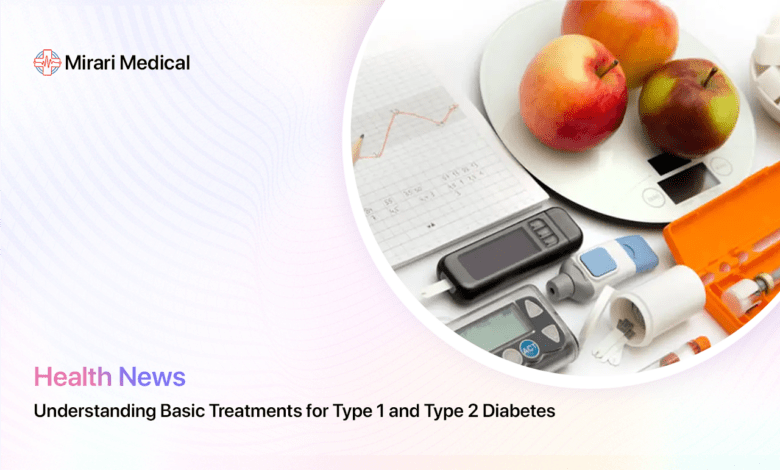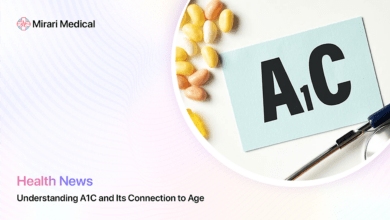Understanding Basic Treatments for Type 1 and Type 2 Diabetes

You may be interested
Diabetes is a chronic condition that affects millions of people worldwide. It occurs when the body cannot properly regulate blood sugar levels, either due to a lack of insulin production (Type 1 diabetes) or an inability to effectively use the insulin produced (Type 2 diabetes). While both types of diabetes can lead to serious health complications if left untreated, the good news is that with proper management and treatment, people with diabetes can live healthy, fulfilling lives. In this article, we’ll explore the key differences between Type 1 and Type 2 diabetes and compare the basic treatments for each type.
Understanding the Differences Between Type 1 and Type 2 Diabetes
Before we dive into the treatments for diabetes, it’s important to understand the fundamental differences between Type 1 and Type 2 diabetes. Both types involve problems with insulin, a hormone produced by the pancreas that helps regulate blood sugar levels. However, the underlying causes and onset of each type differ significantly.
What is Type 1 Diabetes?
Type 1 diabetes, also known as juvenile diabetes or insulin-dependent diabetes mellitus (IDDM), is an autoimmune condition that usually develops in childhood or adolescence. In Type 1 diabetes, the body’s immune system mistakenly attacks and destroys the insulin-producing beta cells in the pancreas. As a result, the body produces little to no insulin.
Causes of Type 1 Diabetes
The exact cause of Type 1 diabetes is not fully understood, but it is believed to involve a combination of genetic and environmental factors. Researchers have identified certain genes that increase the risk of developing Type 1 diabetes, but not everyone with these genes will develop the condition. Environmental triggers, such as viral infections, may also play a role in the development of Type 1 diabetes.
Symptoms of Type 1 Diabetes
Symptoms of Type 1 diabetes often develop quickly and can be severe. They may include:
- Increased thirst
- Frequent urination
- Extreme hunger
- Unintended weight loss
- Fatigue
- Blurred vision
- Slow-healing wounds
If left untreated, Type 1 diabetes can lead to a life-threatening condition called diabetic ketoacidosis (DKA), which occurs when the body starts breaking down fat for energy, producing high levels of blood acids called ketones.
What is Type 2 Diabetes?
Type 2 diabetes, also known as adult-onset diabetes or non-insulin-dependent diabetes mellitus (NIDDM), is a metabolic disorder that usually develops in adulthood, although it is becoming more common in children and adolescents due to the rise in childhood obesity. In Type 2 diabetes, the body becomes resistant to the effects of insulin, and the pancreas may not produce enough insulin to overcome this resistance.
Causes of Type 2 Diabetes
Type 2 diabetes is often associated with certain lifestyle factors, such as:
- Being overweight or obese
- Physical inactivity
- Poor diet, particularly one high in processed and sugary foods
Other risk factors for Type 2 diabetes include:
- Family history of diabetes
- Age (risk increases as you get older)
- Ethnicity (some ethnic groups have a higher risk)
- History of gestational diabetes
- Polycystic ovary syndrome (PCOS)
Symptoms of Type 2 Diabetes
Symptoms of Type 2 diabetes often develop gradually and may be mild at first. They may include:
- Increased thirst
- Frequent urination
- Increased hunger
- Unintended weight loss
- Fatigue
- Blurred vision
- Slow-healing wounds
- Frequent infections
Many people with Type 2 diabetes may not experience symptoms initially, which is why regular check-ups with your healthcare provider are important, especially if you have risk factors for the condition.
Treatment Options for Type 1 Diabetes
Since individuals with Type 1 diabetes cannot produce their own insulin, the primary treatment is insulin replacement therapy. This involves taking insulin through injections or an insulin pump to help regulate blood sugar levels.
The Importance of Insulin for Type 1 Diabetes
Insulin is a vital hormone that helps the body use glucose (sugar) for energy. In people with Type 1 diabetes, the pancreas cannot produce insulin, so it must be replaced through external means. Without insulin, glucose cannot enter the body’s cells and instead builds up in the bloodstream, leading to high blood sugar levels and potential complications.
Types of Insulin
There are several types of insulin available, each with different onset, peak, and duration times:
Rapid-acting Insulin
- Onset: 15 minutes
- Peak: 1 hour
- Duration: 2-4 hours
Short-acting Insulin
- Onset: 30 minutes
- Peak: 2-3 hours
- Duration: 3-6 hours
Intermediate-acting Insulin
- Onset: 2-4 hours
- Peak: 4-12 hours
- Duration: 12-18 hours
Long-acting Insulin
- Onset: Several hours
- Peak: No peak
- Duration: 24 hours or longer
Your healthcare provider will work with you to determine the best type or combination of insulin for your individual needs.
How Insulin is Delivered
Insulin can be delivered in two main ways:
Insulin Injections
- Insulin is injected subcutaneously (under the skin) using a syringe or insulin pen.
- Injections are typically needed multiple times per day, before meals and at bedtime.
Insulin Pumps
- An insulin pump is a small, computerized device that delivers insulin continuously through a small catheter inserted under the skin.
- The pump can be programmed to deliver basal (background) insulin and bolus doses for meals or corrections.
- Insulin pumps can offer more flexibility and precision in insulin delivery compared to injections.
Continuous glucose monitoring (CGM) systems can also be used in conjunction with insulin therapy to provide real-time blood sugar data and help guide treatment decisions. CGMs use a small sensor inserted under the skin to measure glucose levels in the interstitial fluid every few minutes.
Treatment Options for Type 2 Diabetes
Treatment for Type 2 diabetes often begins with lifestyle changes, such as adopting a healthy diabetic diet, increasing physical activity, and losing weight if needed. If these changes are not enough to control blood sugar levels, medications may be prescribed.
Managing Type 2 Diabetes Without Medication
For some people with Type 2 diabetes, lifestyle modifications alone may be sufficient to manage their condition, at least initially. Two key components of a healthy lifestyle for diabetes management are diet and exercise.
Importance of Diet and Exercise for Blood Sugar Control
A healthy diabetic diet is crucial for managing blood sugar levels and reducing the risk of complications. Some key principles of a diabetic meal plan include:
Creating a Healthy Diabetic Meal Plan
- Choosing complex carbohydrates (whole grains, legumes, fruits, and vegetables) over simple carbs (sugary and processed foods)
- Incorporating lean proteins (fish, poultry, tofu) and healthy fats (avocados, nuts, olive oil)
- Monitoring portion sizes and carbohydrate intake
- Eating regular, balanced meals to avoid extreme blood sugar fluctuations
In addition to a healthy diet, regular physical activity is important for blood sugar management. Exercise helps improve insulin sensitivity, allowing the body to use insulin more effectively.
Regular Physical Activity for Blood Sugar Management
- Aim for at least 150 minutes of moderate-intensity aerobic activity per week, spread out over at least 3 days
- Include resistance training (weights or bodyweight exercises) at least 2 times per week
- Break up prolonged sitting with short bouts of activity every 30 minutes
- Find activities you enjoy to make exercise a sustainable part of your lifestyle
Losing excess weight, if applicable, can also significantly improve insulin sensitivity and blood sugar control in people with Type 2 diabetes.
Medications for Type 2 Diabetes
If lifestyle changes alone are not enough to manage blood sugar levels, medications may be necessary. There are several classes of medications used to treat Type 2 diabetes, each with a different mechanism of action.
Oral Medications for Type 2 Diabetes
Oral medications are often the first line of treatment for Type 2 diabetes when blood sugar levels are not adequately controlled with lifestyle changes alone. Some common classes of oral medications include:
Examples of Oral Medications
- Metformin: Reduces the amount of glucose produced by the liver and improves insulin sensitivity.
- Sulfonylureas: Stimulate the pancreas to produce more insulin.
- Thiazolidinediones: Improve insulin sensitivity in muscle and fat cells.
- DPP-4 inhibitors: Help the body produce more insulin and reduce glucose production.
- SGLT2 inhibitors: Prevent the kidneys from reabsorbing glucose, allowing excess glucose to be excreted in the urine.
It’s important to note that oral medications may have side effects, such as gastrointestinal upset, weight gain, or an increased risk of hypoglycemia (low blood sugar). Your healthcare provider will work with you to find the best medication or combination of medications for your individual needs.
Injectable Medications for Type 2 Diabetes
In some cases, injectable medications may be prescribed for people with Type 2 diabetes, either alone or in combination with oral medications.
When is Injectable Medication Needed?
Injectable medications may be recommended when:
- Oral medications and lifestyle changes are not enough to control blood sugar levels.
- Blood sugar levels are very high.
- The pancreas is producing very little insulin.
Two main types of injectable medications used in Type 2 diabetes treatment are:
- GLP-1 receptor agonists: These medications slow down digestion, increase insulin production, and reduce glucose production by the liver.
- Insulin: In advanced stages of Type 2 diabetes, insulin injections may be necessary to control blood sugar levels.
Living a Healthy Life with Diabetes
While managing diabetes can be challenging, it’s possible to live a healthy and fulfilling life with the right tools and support. In addition to medical treatment, there are several key aspects of diabetes management that can help you maintain good blood sugar control and reduce the risk of complications.
Blood Sugar Monitoring: A Crucial Tool for Diabetes Management
Regularly monitoring your blood sugar levels is one of the most important things you can do to manage your diabetes effectively.
Why Monitor Blood Sugar?
Monitoring your blood sugar helps you:
- Understand how your diet, exercise, and medications affect your blood sugar levels.
- Identify patterns and trends in your blood sugar control.
- Detect and prevent high or low blood sugar episodes.
- Make informed decisions about your diabetes management plan.
How to Monitor Blood Sugar
There are two main ways to monitor blood sugar:
- Finger prick tests: This involves using a small device called a glucometer to measure the glucose level in a drop of blood from your fingertip. Most people with diabetes should check their blood sugar several times a day.
- Continuous Glucose Monitoring (CGM): A CGM system uses a small sensor inserted under the skin to measure glucose levels in the interstitial fluid every few minutes. This provides real-time data on blood sugar trends and can alert you to high or low blood sugar levels.
Your healthcare provider can help you determine the best blood sugar monitoring schedule for your individual needs.
Importance of Regular Doctor Visits
Regular check-ups with your healthcare provider are essential for managing diabetes and preventing complications. During these visits, your doctor will:
- Review your blood sugar logs and A1C results
- Assess your medication regimen and make adjustments if needed
- Check for signs of complications
- Provide guidance on lifestyle management
- Address any concerns or questions you may have
Most people with diabetes should see their healthcare provider every 3-6 months, or more frequently if needed.
Maintaining a Healthy Weight
Maintaining a healthy weight is crucial for people with diabetes, especially those with Type 2 diabetes. Excess body weight can increase insulin resistance and make it harder to control blood sugar levels.
Some tips for maintaining a healthy weight include:
- Following a balanced, diabetic diet
- Controlling portion sizes
- Engaging in regular physical activity
- Setting realistic weight loss goals
- Seeking support from a registered dietitian or weight loss program
Reducing Stress for Better Diabetes Management
Stress can have a significant impact on blood sugar control. When you’re under stress, your body releases hormones that can cause blood sugar levels to rise. Additionally, stress can make it harder to stick to your diabetes management plan.
Some strategies for reducing stress include:
- Practicing relaxation techniques, such as deep breathing or meditation
- Engaging in regular physical activity
- Getting enough sleep
- Seeking support from loved ones or a mental health professional
- Prioritizing self-care activities
FAQs
Can Type 2 Diabetes Be Reversed?
While there is no cure for Type 2 diabetes, it is possible to achieve remission through significant weight loss and lifestyle changes. Remission means that blood sugar levels return to a normal range without the need for medication. However, it’s important to note that remission is not a permanent cure, and diabetes can return if healthy lifestyle habits are not maintained.
What are the Long-Term Complications of Diabetes?
If left unmanaged, diabetes can lead to several serious complications over time, including:
- Heart disease and stroke
- Kidney disease (nephropathy)
- Nerve damage (neuropathy)
- Eye damage (retinopathy)
- Foot problems, such as ulcers and infections
- Skin conditions
- Dental problems
Regular check-ups, good blood sugar control, and a healthy lifestyle can help reduce the risk of these complications.
Are There Any New Advancements in Diabetes Treatment?
Researchers are continually working on new treatments and technologies to improve diabetes management. Some recent advancements include:
- SGLT2 inhibitors and GLP-1 receptor agonists: These newer classes of medications have shown promise in improving blood sugar control and reducing the risk of cardiovascular complications.
- Continuous Glucose Monitoring (CGM) systems: CGMs provide real-time data on blood sugar trends, helping people with diabetes make more informed decisions about their management.
- Artificial pancreas systems: These systems combine a CGM with an insulin pump to automatically adjust insulin delivery based on blood sugar levels. While not yet widely available, they have the potential to greatly improve diabetes management in the future.
How Can I Live a Fulfilling Life with Diabetes?
Living with diabetes can be challenging, but it doesn’t have to hold you back from living a full and active life. Some tips for living well with diabetes include:
- Educate yourself about diabetes management and stay informed about new developments.
- Build a strong support system of healthcare providers, family, and friends.
- Set realistic goals for your diabetes management and celebrate your progress.
- Find ways to incorporate healthy habits into your daily routine, such as taking a walk after meals or trying new healthy recipes.
- Don’t be afraid to seek help when you need it, whether it’s from a healthcare provider, a support group, or a mental health professional.
Remember, with the right tools and mindset, you can thrive with diabetes.
When Should I See a Doctor About Diabetes?
If you have any signs or symptoms of diabetes, such as increased thirst, frequent urination, blurred vision, or slow-healing wounds, it’s important to see a healthcare provider right away. Additionally, if you have risk factors for diabetes, such as a family history of the condition, being overweight, or having a sedentary lifestyle, you should talk to your doctor about getting screened.
If you’ve already been diagnosed with diabetes, you should see your healthcare provider regularly for check-ups and monitoring. Most people with diabetes should have a comprehensive diabetes evaluation at least once a year, in addition to more frequent visits for blood sugar monitoring and medication adjustments.
Key Takeaways
Type 1 diabetes and Type 2 diabetes are two distinct conditions that require different treatment approaches:
- Type 1 diabetes is an autoimmune condition that requires lifelong insulin replacement therapy, as the body cannot produce its own insulin.
- Type 2 diabetes is a metabolic disorder that can often be managed initially with lifestyle changes and oral medications, with insulin therapy added if needed.
- Both types of diabetes require regular blood sugar monitoring, a healthy diabetic diet, and regular physical activity for optimal management.
- Advances in diabetes technology, such as continuous glucose monitoring and insulin pumps, can help improve diabetes management and quality of life.
- Living with diabetes can be challenging, but with the right tools, support, and mindset, it is possible to thrive and live a fulfilling life.
Conclusion
In conclusion, while Type 1 and Type 2 diabetes share the common challenge of managing blood sugar levels, their underlying causes and primary treatment approaches differ significantly. Type 1 diabetes requires lifelong insulin therapy, while Type 2 diabetes can often be managed with a combination of lifestyle changes, oral medications, and sometimes insulin.
Regardless of the type of diabetes, adopting a healthy lifestyle, regularly monitoring blood sugar levels, and working closely with healthcare providers are essential for effectively managing the condition and preventing complications. With the right knowledge, tools, and support, people with diabetes can live full, active, and healthy lives.
Remember, every person’s diabetes journey is unique, and what works for one person may not work for another. It’s important to work with your healthcare team to develop a personalized management plan that fits your individual needs and goals. Don’t hesitate to reach out for help and support when you need it – you don’t have to face diabetes alone.
Your trusted source for health info, offering expert advice, news, and tips to stay healthy and informed.





